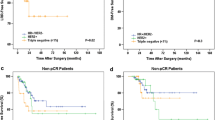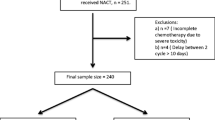Abstract
Purpose
To study the role of breast cancer molecular subtypes according to hormone receptors and HER2 status as a predictive factor for pathological complete response (pCR) to neoadjuvant chemotherapy.
Patients and methods
Eligible patients received one of the two chemotherapy schedules every two weeks with prophylactic growth factor support; schedule A: epirubicin 90 mg/m2-cyclophosphamide 600 mg/m2 d1 for 3 cycles followed by a second sequence with paclitaxel (P) 150 mg/m2-gemcitabine (G) 2500 mg/m2 d1±trastuzumab (T) 2 mg/kg/week according to HER2 status (n=73); schedule B: adriamycin (40 mg/m2) d1 plus P (150 mg/m2)-G (2000 mg/m2) d2 for 6 cycles (n=54). Subsequently, patients underwent surgery, radiotherapy and/or adjuvant hormonal therapy according to standard practice.
Results
A total of 127 patients were evaluated. Forty-three patients (33.9%) achieved a pCR (50% in patients with HER2+tumours treated with T). Patients treated with chemotherapy alone (n=107, 18 HER2+) had a pCR of 32% (p=0.068). The pCR rate for patients with triple negative (HR and HER2−) cancers was 58.3%, 39.5% for HER2+ and 5.4% for ER/PR+ and HER2− (p<0.001). No differences in disease-free survival (DFS) were noted as a function of pCR, HER2 and HR status or treatment received (±T). However, statistical differences in DFS were observed as a function of whether patients had + or − axillar lymph nodes. Patients with + lymph node disease did worse (3 years DFS of 53.7% vs. 81.5%, p=0.025). Breastconserving surgery was performed in 77 patients (60.6%).
Conclusion
Tumour molecular subtyping defines different pCR to neoadjuvant chemotherapy (NC) but has no impact over DFS in patients with LABC. Although no significant correlation between HER2 status and trastuzumab therapy with pCR was found, probably due to the small number of patients, a favourable trend was observed in the group of HER2+ tumours treated with T.
Similar content being viewed by others
References
Jensen OM, Esteve J, Moller H et al (1990) Cancer in the European community and its member states. Eur J Cancer 26:1167–1256
American Cancer Society (1995) Cancer facts and figures. National Media Office, New York, NY [Brochure]
Early Breast Cancer Trialists’ Collaborative Group (EBCTCG) (2005) Effects of chemotherapy and hormonal therapy for early breast cancer on recurrence and 15-year survival: an overview of the randomised trials. Lancet 365:1687–1717
Harris JR, Marrow M, Bonadonna G (1993) Cancer of the breast. In Devita VT Jr, Hellman S, Rosenberg SA (eds) Cancer: principles and practice of oncology, 4th Edn. Lippincott, Philadelphia, PA, pp 1264–1332
Mouridsen HT (1992) Systemic therapy of advanced breast cancer. Drugs 44:17–28
Carmichael J, Possinger K, Philip P et al (1995) Advanced breast cancer: a phase II trial with gemcitabine. J Clin Oncol 17:2731–2736
Possinger K, Kaufmann M, Coleman R et al (1999) Phase II study of gemcitabine as first-line chemotherapy in patients with advanced or metastatic breast cancer. Anti-cancer Drugs 10: 155–162
Spielman M, Kalla S, Llombart-Cussac A et al (1997) Activity of gemcitabine in metastatic breast cancer (MBC) patients previously treated with anthracycline containing regimens. Eur J Cancer 33:A663
Blackstein M, Vogel CL, Ambinder R et al (1997) Phase II study of gemcitabine in patients with metastatic breast cancer. Eur J Cancer 33:A664
Brodowicz T, Moslinger R, Herscovici V et al (1998) Second and third line treatment of metastatic breast cancer with gemcitabine. Eur J Cancer 34:S44
Akrivakis K, Schmid P, Flath B et al (1999) Prolonged infusion of gemcitabine in stage IV breast cancer: a phase I study. Anti-cancer Drugs 10: 525–531
Schmid P, Akrivakis K, Flath B et al (1999) Phase II trial of gemcitabine as prolonged infusion in metastatic breast cancer. Anti-cancer Drugs 10:625–631
Bonadonna G, Valagussa P, Brambilla C (1998) Primary chemotherapy in operable breast cancer: eight year experience at the Milan Cancer Institute. J Clin Oncol 16:93–100
Kuerer HM, Newman LA, Smith TL (1999) Clinical course of breast cancer patients with complete pathologic primary tumor and axillary lymph node response to doxorubicin-based neoadjuvant chemotherapy. J Clin Oncol 17:460–469
Van der Hage JA, van de Velde CJ, Julien JP et al (2001) Preoperative chemotherapy in primary operable breast cancer: results from the European Organization for Research and Treatment of Cancer Trial 10902. J Clin Oncol 19:4224–4237
Fisher B, Bryant J, Wolmark N et al (1998) Effect of preoperative chemotherapy on the outcome of women with operable breast cancer. J Clin Oncol 16:2672–2685
Gilmore PM, McCabe N, Quinn JE et al (2004) BRCA1 interacts with and is required for paclitaxel-induced activation of mitogen-activated protein kinase kinase 3. Cancer Res 64:4148–4154
Conti F, Sergi D, Foggi P et al (2007) New combination chemotherapy regimens in the primary treatment of operable breast cancer. Clin Ther 158:55–75
Hess KR, Anderson K, Symmans WF et al (2006) Pharmacogenomic predictor of sensitivity to preoperative chemotherapy with paclitaxel and fluorouracil, doxorubicin, and cyclophosphamide in breast cancer. J Clin Oncol 24:4236–4244
Rouzier R, Rajan R, Wagner P et al (2005) Microtubule-associated protein tau: a marker of paclitaxel sensitivity in breast cancer. Proc Natl Acad Sci USA 102:8315–8320
Baselga J, Tripathy D, Mendelson J et al (1996) Phase II study of weekly intravenous recombinant humanized antip185HER2 monoclonal antibody in patients with Her2/neu overexpressing metastatic breast cancer. J Clin Oncol 14:737–744
Cobleigh MA, Vogel CL, Tripathy D et al (1998) Efficacy and safety of Herceptin as a single agent in 222 women with HER2 overexpression who relapsed following chemotherapy for metastatic breast cancer. Proc Am Soc Clin Oncol 17:abstr 376
Smith I, Procter M, Gelber RD et al (2007) 2-year follow-up of trastuzumab after adjuvant chemotherapy in HER2-positive breast cancer: a randomised controlled trial. Lancet 369:29–36
Romond EH, Perez EA, Bryant J et al (2005) Trastuzumab plus adjuvant chemotherapy for operable Her2-positive breast cancer. N Engl J Med 353:1673–1684
Slamon D, Eiermann W, Robert N et al (2005) Phase III randomized trial comparing doxorubicin and cyclophosphamide followed by docetaxel (AC.T) with doxorubicin and cyclophosphamide followed by docetaxel and trastuzumab (AC.TH) with docetaxel, carboplatin and trastuzumab (TCH) in Her2neu positive early breast cancer patients: BCIRG 006 study. Breast Cancer Res Treat 94:S5
Slamon D, Leyland-Jones B, Shak S et al (2001) Use of chemotherapy plus a monoclonal antibody against HER2 for metastatic breast cancer that overexpresses HER2. N Engl J Med 344:783–792
Ross JS, Fletcher JA (1998) The HER-2/neu oncogene in breast cancer: prognostic factor, predictive factor, and target for therapy. Stem Cells 16:413–428
Perou CM, Sorlie T, Eisen MD et al (2000) Molecular portraits of human breast tumors. Nature 406:747–752
Rouzier R, Perou CM, Symmans WF et al (2005) Breast cancer molecular subtypes respond differently to preoperative chemotherapy. Clin Cancer Res 11:5678–5685
Sorlie T, Perou CM, Tibshirani R et al (2001) Gene expression patterns of breast carcinomas distinguish tumor subclasses with clinical implications. Proc Natl Acad Sci USA 198:10869–10874
Sorlie T, Tibshirani R, Parker J et al (2003) Repeated observation of breast tumor subtypes in independent gene expression data sets. Proc Natl Acad Sci USA 100:8418–8423
Sotiriou C, Neo SY, McShane LM et al (2003) Breast cancer classification and prognosis based on gene expression profiles from a population-based study. Proc Natl Acad Sci USA 100:10393–10398
Kaufmann M, Hortobagyi GN, Goldhirsch A et al (2006) Recommendations from an international expert panel on the use of neoadjuvant (primary) systemic treatment of operable breast cancer: an update. J Clin Oncol 24:1940–1949
Mamounas EP (2005) Can we approach zero relapse in breast cancer? Oncologist 10:9–17
Bear HD, Anderson S, Brown A et al (2003) The effect on tumor response of adding sequential preoperative docetaxel to preoperative doxorubicin and cyclophosphamide: preliminary results from National Surgical Adjuvant Breast and Bowel Project Protocol B-27. J Clin Oncol 21:4165–4174
Smith I, Heys SD, Hutcheon AW et al (2002) Neoadjuvant chemotherapy in breast cancer: significantly enhanced response with docetaxel. J Clin Oncol 20:1456–1466
Gianni L, Baselga J, Eiermann W et al (2005) European Cooperative Trial in operable breast cancer (ECTO): improved freedom from progression from adding paclitaxel to doxorubicin followed by cyclophosphamide methotrexate and fluorouracil. Proc Am Soc Clin Oncol 7s:Abstr 513
Sánchez-Rovira P, Medina MB, Mohedano N et al (1998) Results from a phase II study of gemcitabine in combination with paclitaxel in metastatic breast cancer. Ann Oncol 9:16 [abstract 77]
Murad AM, Guimaraes RC, Aragao BC et al (2001) Phase III trial of the use of paclitaxel and gemcitabine as a salvage treatment in metastatic breast cancer. Am J Clin Oncol 24:264–268
Colomer R, Llombart A, Llunch A et al (2004) Biweekly paclitaxel and gemcitabine in advanced breast cancer. Phase II trial and predictive value of HER2 extracellular domain (ECD). Ann Oncol 15:201–206
Citron M, Berry D, Cirrincione C et al (2003) Randomized trial of dose-dense versus conventionally scheduled and sequential versus combination chemotherapy as postoperative adjuvant treatment for node-positive primary breast cancer: First report of Intergroup Trial C9741/Cancer and Leukemia Group B Trial 9741. J Clin Oncol 21: 1431–1439
Estévez LG, Gradishar WJ (2004) Evidence-based use of neoadjuvant taxane in operable and inoperable breast cancer. Clin Cancer Res 10:3249–3261
Kandioler-Eckersberger D, Ludwig C, Rudas M et al (2000) TP53 mutation and p53 overexpression for prediction of response to neoadjuvant treatment in breast cancer patients. Clin Cancer Res 6:50–56
Buzdar AU, Valero V, Ibrahim NK et al (2007) Neoadjuvant therapy with paclitaxel followed by 5-fluorouracil, epirubicin, and cyclophosphamide chemotherapy and concurrent trastuzumab in human epidermal growth factor receptor 2-positive operable breast cancer: an update of the initial randomized study population and data of additional patients treated with the same regimen. Clin Cancer Res 13:228–233
Coudert BP, Arnould L, Moreau L et al (2006) Pre-operative systemic (neo-adjuvant) therapy with trastuzumab and docetaxel for HER2-overexpressing stage II or III breast cancer: results of a multicenter phase II trial. Ann Oncol 17:409–414
Colleoni M, Viale G, Zahrieh D et al (2004) Chemo therapy is more effective in patients with breast cancer not expressing steroid hormone receptors: a study of preoperative treatment. Clin Cancer Res 10:6622–6628
Author information
Authors and Affiliations
Corresponding author
Rights and permissions
About this article
Cite this article
Sánchez-Muñoz, A., García-Tapiador, A.M., Martínez-Ortega, E. et al. Tumour molecular subtyping according to hormone receptors and HER2 status defines different pathological complete response to neoadjuvant chemotherapy in patients with locally advanced breast cancer. Clin Transl Oncol 10, 646–653 (2008). https://doi.org/10.1007/s12094-008-0265-y
Received:
Accepted:
Published:
Issue Date:
DOI: https://doi.org/10.1007/s12094-008-0265-y




